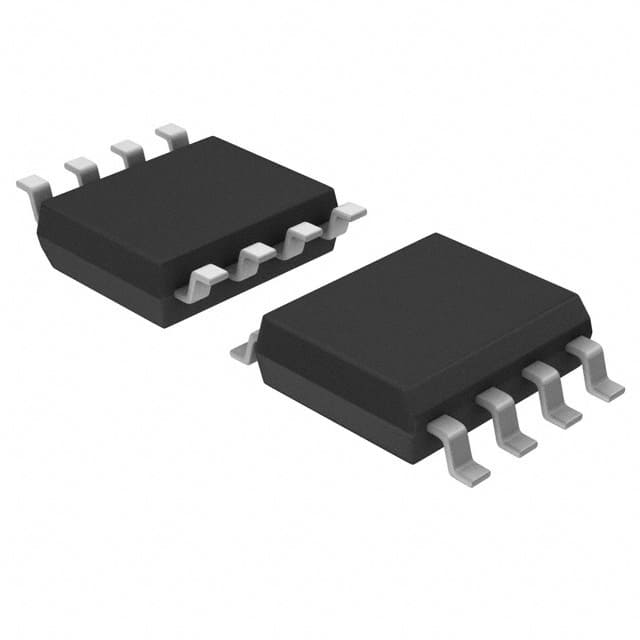ATTINY13V-10SU
Product Overview
Category
The ATTINY13V-10SU belongs to the category of microcontrollers.
Use
This microcontroller is commonly used in various electronic devices and applications that require embedded control systems.
Characteristics
- Low-power consumption
- High-performance 8-bit AVR microcontroller
- Compact size
- Wide operating voltage range
- Flash memory for program storage
- EEPROM for data storage
- In-system programmable
- Multiple I/O pins for interfacing with external components
Package
The ATTINY13V-10SU is available in a surface-mount package, specifically the SOIC-8 (Small Outline Integrated Circuit) package.
Essence
The essence of the ATTINY13V-10SU lies in its ability to provide efficient and reliable control capabilities in a compact form factor, making it suitable for various applications where space and power consumption are critical factors.
Packaging/Quantity
The ATTINY13V-10SU is typically packaged in reels or tubes, containing a quantity of 250 or 300 units per package.
Specifications
- Microcontroller Architecture: AVR
- CPU Speed: 10 MHz
- Flash Memory: 1 KB
- RAM: 64 Bytes
- EEPROM: 64 Bytes
- Operating Voltage Range: 1.8V - 5.5V
- Digital I/O Pins: 6
- Analog Input Pins: 4
- PWM Channels: 2
- Communication Interfaces: SPI, USART
- Timers/Counters: 1 x 8-bit, 1 x 16-bit
- Operating Temperature Range: -40°C to +85°C
Detailed Pin Configuration
The ATTINY13V-10SU has a total of 8 pins, which are assigned specific functions as follows:
- VCC: Power supply voltage input
- GND: Ground reference
- PB5 (RESET): Reset pin for restarting the microcontroller
- PB3 (MISO/DO): Master In Slave Out / Data Output pin for SPI communication
- PB4 (SCK/SCL): Serial Clock / Serial Clock Line pin for SPI or I2C communication
- PB0 (MOSI/DI/SDA): Master Out Slave In / Data Input / Serial Data Line pin for SPI or I2C communication
- PB1 (OC0A): Output Compare Match A pin for PWM output
- PB2 (OC0B): Output Compare Match B pin for PWM output
Functional Features
- Low-power consumption: The ATTINY13V-10SU is designed to operate efficiently with minimal power requirements, making it suitable for battery-powered applications.
- In-system programmable: The microcontroller can be programmed while it is connected to the target system, allowing for easy updates and modifications.
- Multiple I/O pins: The ATTINY13V-10SU provides a sufficient number of digital and analog I/O pins for interfacing with external components and sensors.
- Communication interfaces: It supports SPI and USART communication protocols, enabling seamless integration with other devices.
- Timers/Counters: The microcontroller features timers/counters that can be utilized for precise timing and event counting.
Advantages and Disadvantages
Advantages
- Compact size and low-power consumption make it suitable for portable and battery-powered applications.
- In-system programmability allows for easy updates and modifications.
- Wide operating voltage range enhances compatibility with various power sources.
- Sufficient I/O pins enable versatile interfacing capabilities.
- Support for communication interfaces facilitates integration with other devices.
Disadvantages
- Limited program memory and RAM may restrict the complexity of applications.
- Limited number of I/O pins may pose limitations in certain projects requiring extensive interfacing.
Working Principles
The ATTINY13V-10SU operates based on the AVR architecture, utilizing a RISC (Reduced Instruction Set Computer) design. It executes instructions stored in its flash memory, interacting with external components through its I/O pins. The microcontroller can be programmed using appropriate development tools and software, enabling the execution of specific tasks and control algorithms.
Detailed Application Field Plans
The ATTINY13V-10SU finds applications in various fields, including but not limited to: - Home automation systems - Consumer electronics - Industrial control systems - Internet of Things (IoT) devices - Sensor networks - Automotive electronics - Medical devices
Detailed and Complete Alternative Models
- ATTINY25V-10SU: Similar features and specifications, but with increased program memory and I/O pins.
- ATTINY85-20PU: Higher clock speed and more program memory, suitable for more complex applications.
- ATTINY2313A-PU: Enhanced capabilities with additional peripherals and larger program memory.
These alternative models provide options with varying capabilities to suit different project
Lista 10 Vanliga frågor och svar relaterade till tillämpningen av ATTINY13V-10SU i tekniska lösningar
Sure! Here are 10 common questions and answers related to the application of ATTINY13V-10SU in technical solutions:
Q: What is the ATTINY13V-10SU microcontroller used for? A: The ATTINY13V-10SU is a low-power, high-performance microcontroller commonly used in various embedded systems and IoT applications.
Q: What is the operating voltage range of the ATTINY13V-10SU? A: The ATTINY13V-10SU operates within a voltage range of 1.8V to 5.5V.
Q: How many I/O pins does the ATTINY13V-10SU have? A: The ATTINY13V-10SU has a total of 6 I/O pins, which can be configured as either digital inputs or outputs.
Q: What is the maximum clock frequency supported by the ATTINY13V-10SU? A: The ATTINY13V-10SU supports a maximum clock frequency of 10 MHz.
Q: Can the ATTINY13V-10SU be programmed using the Arduino IDE? A: Yes, the ATTINY13V-10SU can be programmed using the Arduino IDE with the help of an external programmer.
Q: Does the ATTINY13V-10SU have built-in analog-to-digital converters (ADC)? A: Yes, the ATTINY13V-10SU has a single 10-bit ADC channel, allowing it to convert analog signals into digital values.
Q: What programming languages can be used to program the ATTINY13V-10SU? A: The ATTINY13V-10SU can be programmed using C/C++ language with the help of development tools like Atmel Studio or Arduino IDE.
Q: Can the ATTINY13V-10SU communicate with other devices using serial communication protocols? A: Yes, the ATTINY13V-10SU supports serial communication protocols like I2C and SPI, allowing it to communicate with other devices such as sensors and displays.
Q: What is the flash memory size of the ATTINY13V-10SU? A: The ATTINY13V-10SU has a flash memory size of 1KB, which can be used to store program code.
Q: Is the ATTINY13V-10SU suitable for battery-powered applications? A: Yes, the ATTINY13V-10SU is designed to operate at low power and has various power-saving features, making it ideal for battery-powered applications.
Please note that these answers are general and may vary depending on specific application requirements and configurations.


